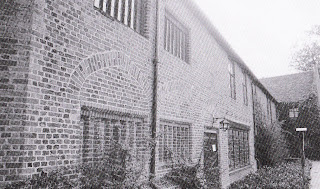 |
| Cover of the new edition 2000 |
I am back in Eltham where I grew up in the 1960s on the
Progress Estate.
They say you should never go back to the places of your
childhood and there is something in that.
Either they look smaller and are just that bit different or whole landscapes have so altered that you begin to question if your memory is serving you well.
Now my bit of Well Hall looks much the same but they have
moved the station built a motorway and many of my favourite haunts in the High
Street have changed.
All of which is a lead in to Discover Eltham by Darrell
Sprugeon.*
It is a “comprehensive guide to Eltham, New Eltham,
Mottingham, Kidbrooke and Shooters Hill.” So it pretty much covers everywhere I went as
a child and certainly everywhere I would want to take my own grown children who
while they are all Mancunians have a soft spot for where dad lived.
Mr Spurgeon sets out to offer his reader a mix of history,
and places to see which are all wrapped up in a series of walks “but only where
places of interest are concentrated within an area which makes walking
practicable and interesting.”
 |
| Tudor Barn, Well Hall, 16th century |
So “beside the famous buildings of royal Eltham, the area
covered includes Wren’ great almshouse of Morden College, the extraordinary
Sevendroog Castle, set amongst the ancient woodland of Shooters Hill, the Tudor
remains of Well Hall, many interesting Victorian churches and two striking
churches of the 1930s, two remarkable housing estates of the 20th century;
sites of industrial archaeology, interesting pubs; many of which remain rural
in character, and much more.”
And there is much I didn’t know. So despite living close to
the church of St Barnabas on Rochester Way, I had no idea that this red brick
Victorian church was originally the chapel of the Royal Naval Dockyard at
Woolwich. It was “built in 1859 and
dismantled and re-erected brick by brick on its present site in 1933.”
Nor did I know of the existence of three streams which flow
through Kidbrook and feed into the
Quaggy River. Of course the clue is in
the name Kidbrook, which is clearly derived from the Upper, Mid and Lower
Kidbrooks.
Now water courses are a particular interest of mine. Most today are buried underground all but
forgotten but they were vital to our rural communities providing water and
acting as boundary markers.
 |
| Progress Estate, Ross Way, 1915 |
I have to own up that it is the Eltham walks which fascinate
me most.
And here there is
plenty to read and see because Mr Spurgeon includes a selection of photographs
along with the text and maps.
The first edition came out in 1992 and a second much revised
eight years later. I have both in front
of me.
The earlier version I bought on
Amazon and the later one has come courtesy of the author.
And as a historian what I finds particularly interesting are
the changes to the area in that eight years. All of which makes the book a
fascinating chronicle of how Eltham has developed.
I rather think that I shall take both with me on some of the
walks, thereby getting an insight into the Eltham of 1992, 2000 and of course
today.
Pictures; courtesy of Darrell Spurgeon
*Spurgeon, Darrell,
Discover Eltham and its Environ, Greenwich Guide Books, 1992, revised and updated 2000
No comments:
Post a Comment